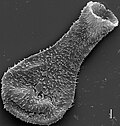Jesse Ventura
|
The Palaeontology Portal
Introduction Paleontology, also spelled as palaeontology or palæontology, is the scientific study of the life of the past, mainly but not exclusively through the study of fossils. Paleontologists use fossils as a means to classify organisms, measure geologic time, and assess the interactions between prehistoric organisms and their natural environment. While paleontological observations are known from at least the 6th century BC, the foundation of paleontology as a science dates back to the work of Georges Cuvier in 1796. Cuvier demonstrated evidence for the concept of extinction and how life of the past was not necessarily the same as that of the present. The field developed rapidly over the course of the following decades, and the French word paléontologie was introduced for the study in 1822, which was derived from the Ancient Greek word for "ancient" and words describing relatedness and a field of study. Further advances in the field accompanied the work of Charles Darwin who popularized the concept of evolution. Together, evolution and extinction can be understood as complementary processes which shaped the history of life. Paleontology overlaps the most with the fields of geology and biology. It draws on technology and analysis of a wide range of sciences to apply them to the study of life and environments of the past, particularly for the subdisciplines of paleobiology and paleoecology that are analogous to biology and ecology. Paleontology also contributes to other sciences, being utilized for biostratigraphy to reconstruct the geologic time scale of Earth, or in studies on extinction to establish both external and internal factors that can lead to the disappearance of a species. Much of the history of life is now better understood because of advances in paleontology and the increase of interdisciplinary studies. Several improvements in understanding have occurred from the introduction of theoretical analysis to paleontology in the 1950s and 1960s that led to the rise of more focused fields of paleontology that assess the changing geography and climate of Earth, the phylogenetic relationships between different species, and the analysis of how fossilization occurs and what biases can impact the quality of the fossil record. (Full article...) Selected article on the prehistoric world and its legacies
Schinderhannes bartelsi is an anomalocarid known from one specimen from the lower Devonian Hunsrück Slates. Its discovery was astonishing because previously, anomalocaridids were known only from exceptionally well-preserved fossil beds (Lagerstätten) from the Cambrian, 100 million years earlier. Anomalocaridids, such as Anomalocaris, were organisms thought to be distantly related to the arthropods. These creatures looked quite unlike any organism living today—they had segmentedexoskeletons, with lateral lobes used for swimming, five large compound eyes, often set on stalks, and most strikingly, a pair of large, claw-like great appendages that resembled headless shrimp. These appendages are thought to have passed food to the animal's mouth, which resembled a ring of pineapple.(see more...)
Did you know?

General images -The following are images from various paleontology-related articles on Wikipedia.
Selected article on paleontology in human science, culture and economics
Edward Drinker Cope (July 28, 1840 – April 12, 1897) was an American paleontologist and comparative anatomist, as well as a noted herpetologist and ichthyologist. Cope distinguished himself as a child prodigy, publishing his first scientific paper at the age of nineteen. Cope later married and moved from Philadelphia to Haddonfield, New Jersey, although Cope would maintain a residence and museum in Philadelphia in his later years.
Cope had little formal scientific training, and he eschewed a teaching position for field work. He made regular trips to the American West prospecting in the 1870s and 1880s, often as a member of United States Geological Survey teams. A personal feud between Cope and paleontologist Othniel Charles Marsh led to a period of intense fossil-finding competition now known as the Bone Wars. Cope's financial fortunes soured after failed mining ventures in the 1880s. He experienced a resurgence in his career toward the end of his life before dying in 1897. Cope's scientific pursuits nearly bankrupted him, but his contributions helped to define the field of American paleontology. He was a prodigious writer, with 1,400 papers published over his lifetime, although his rivals would debate the accuracy of his rapidly published works. He discovered, described, and named more than 1,000 vertebrate species including hundreds of fishes and dozens of dinosaurs. His proposals on the origin of mammalian molars and for the gradual enlargement of mammalian species over geologic time ("Cope's Law") are notable among his theoretical contributions. (see more...) On this day...
Selected image
CategoriesTopicsGeneral - Paleontology - Fossil - Evolution - Extinction Quality ContentFeatured paleontology articles
- Achelousaurus
- Acrocanthosaurus
- Albertosaurus
- Allosaurus
- Amargasaurus
- Ankylosaurus
- Apatosaurus
- Archaeopteryx
- Baryonyx
- Carnotaurus
- Catopsbaatar
- Ceratosaurus
- Chicxulub Crater
- Compsognathus
- Cretaceous–Tertiary extinction event
- Daspletosaurus
- Deinocheirus
- Deinonychus
- Deinosuchus
- Dilophosaurus
- Dinosaur
- Diplodocus
- Dromaeosauroides
- Edmontosaurus
- Elasmosaurus
- Giganotosaurus
- Gorgosaurus
- Herrerasaurus
- Iguanodon
- Istiodactylus
- Lambeosaurus
- List of dinosaur genera
- Majungasaurus
- Massospondylus
- Megalodon
- Nemegtomaia
- Nigersaurus
- Opisthocoelicaudia
- Paranthodon
- Parasaurolophus
- Plateosaurus
- Psittacosaurus
- Seorsumuscardinus
- Spinosaurus
- Stegosaurus
- Stegoceras
- Styracosaurus
- Tarbosaurus
- Thescelosaurus
- Triceratops
- Tyrannosaurus
- Velociraptor
Things you can doCurrent Paleontology FACs - None yet... WikiProjectsRelated portalsAssociated WikimediaThe following Wikimedia Foundation sister projects provide more on this subject:
Discover Wikipedia using portals |

 Read
Read
 AUTHORPÆDIA is hosted by Authorpædia Foundation, Inc. a U.S. non-profit organization.
AUTHORPÆDIA is hosted by Authorpædia Foundation, Inc. a U.S. non-profit organization.








































